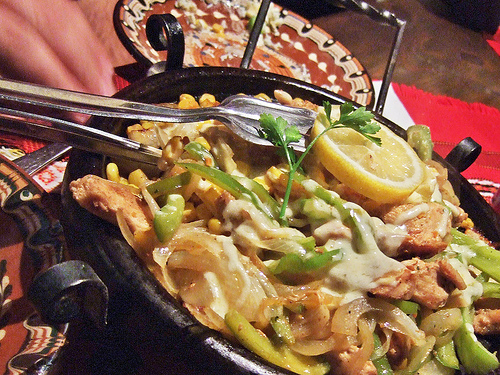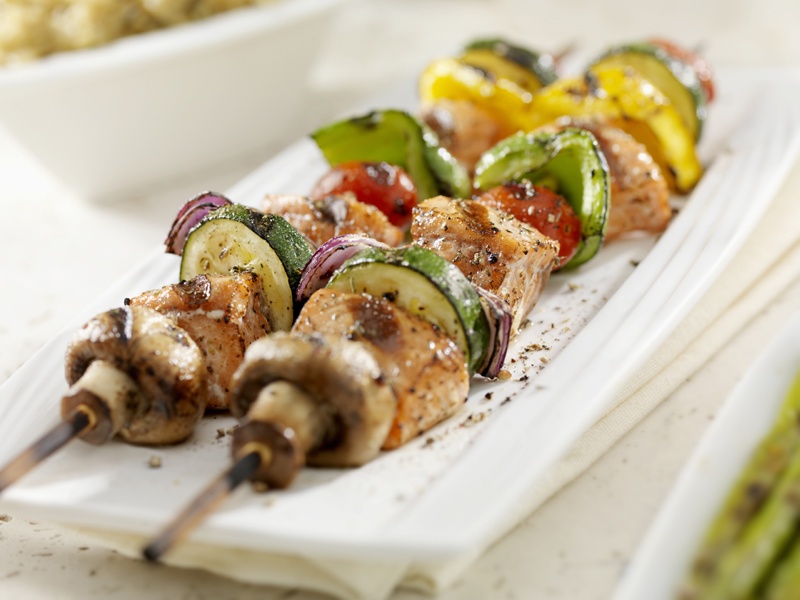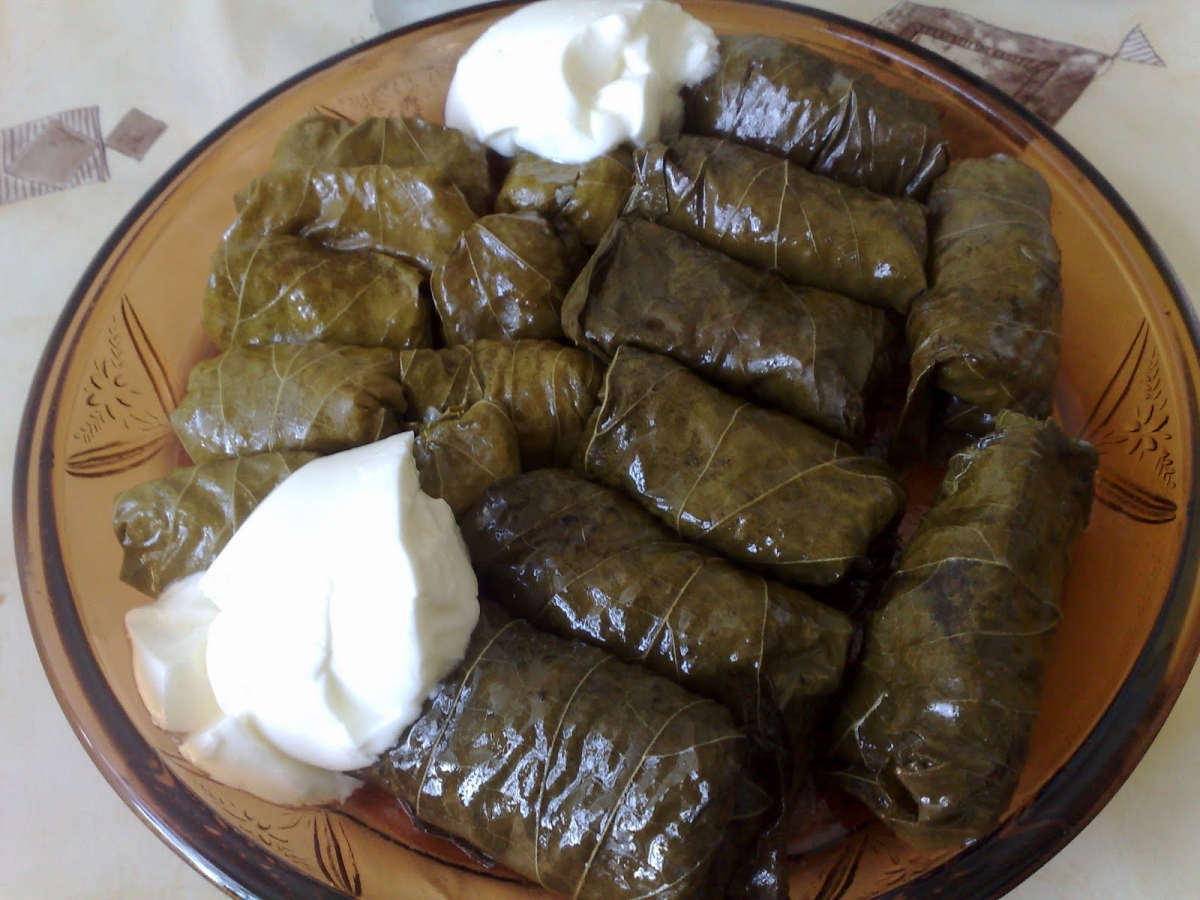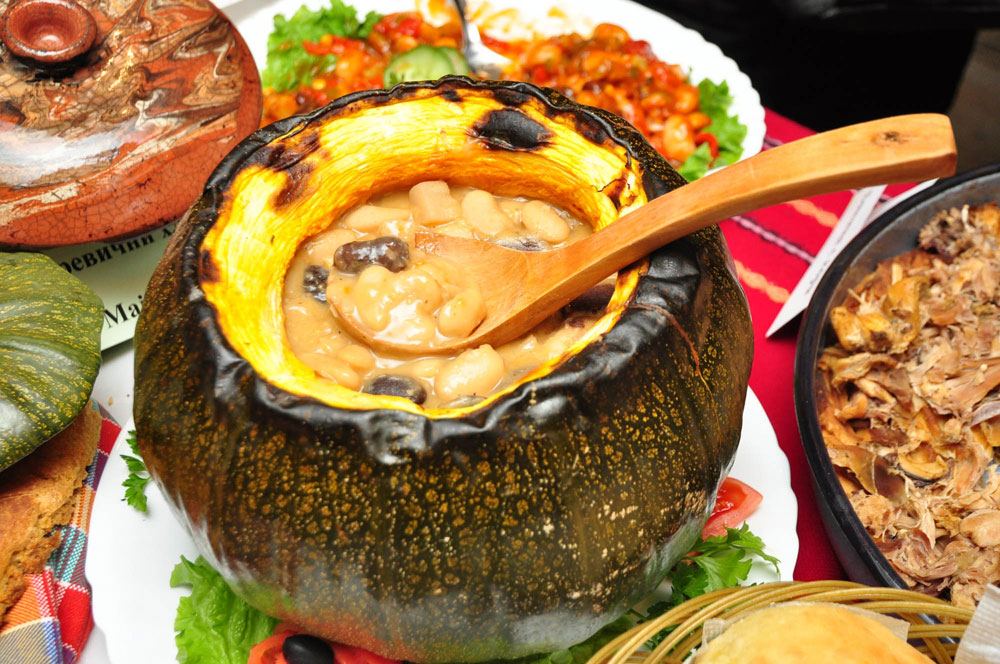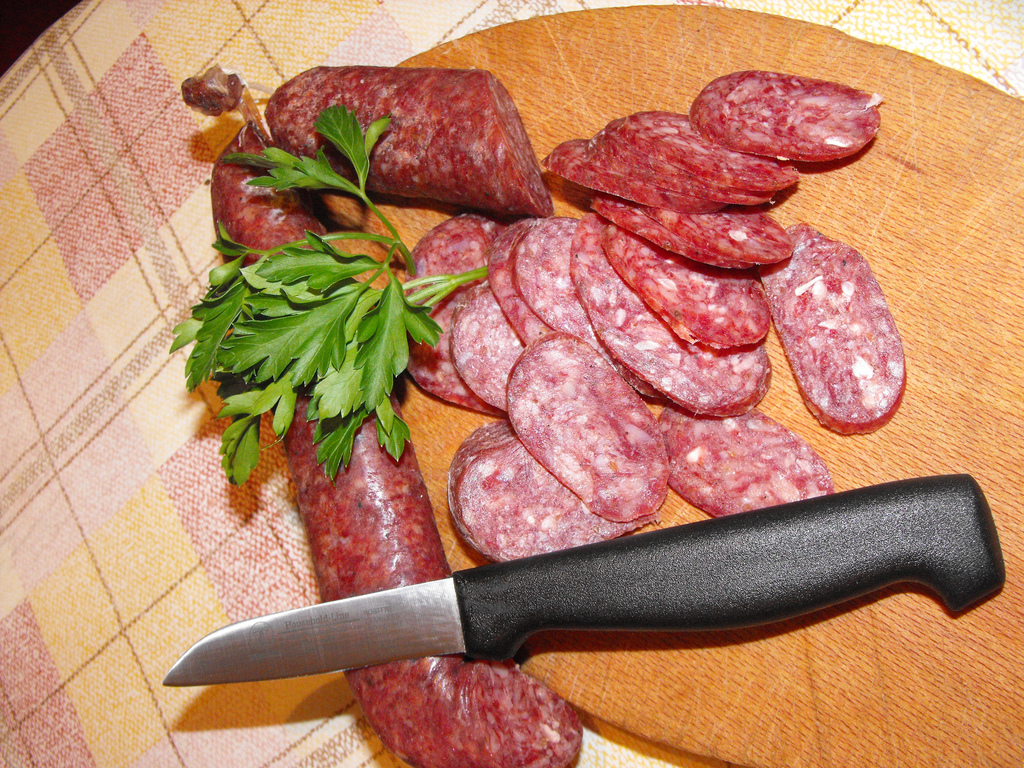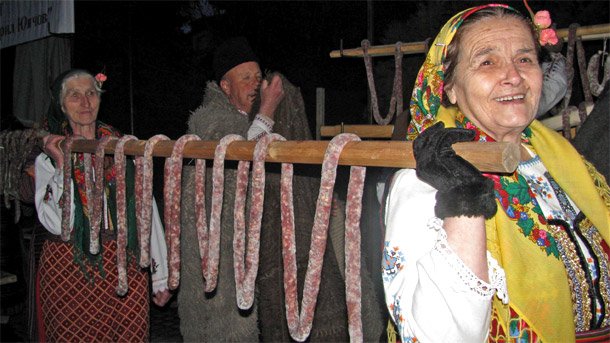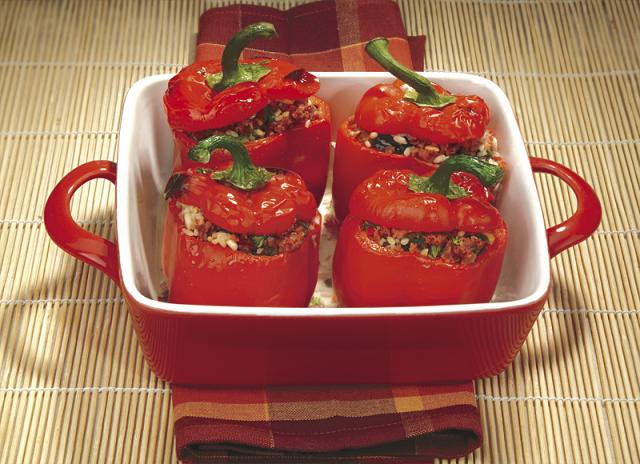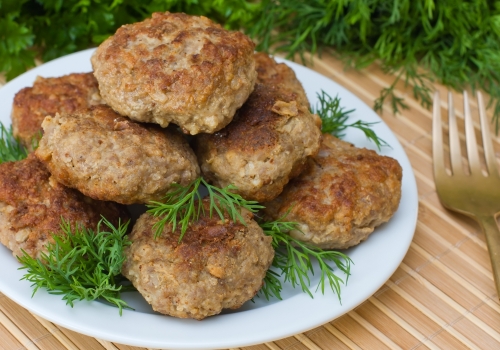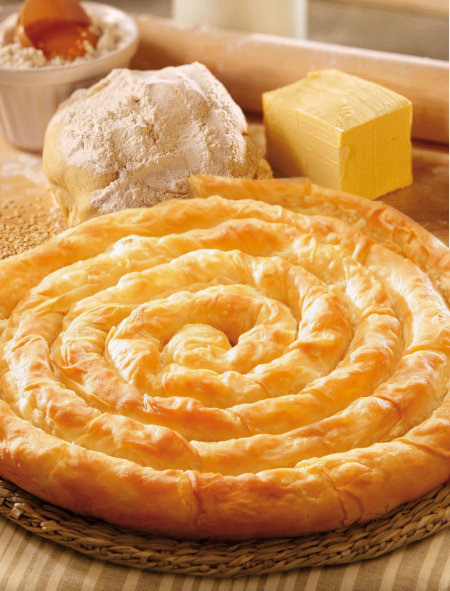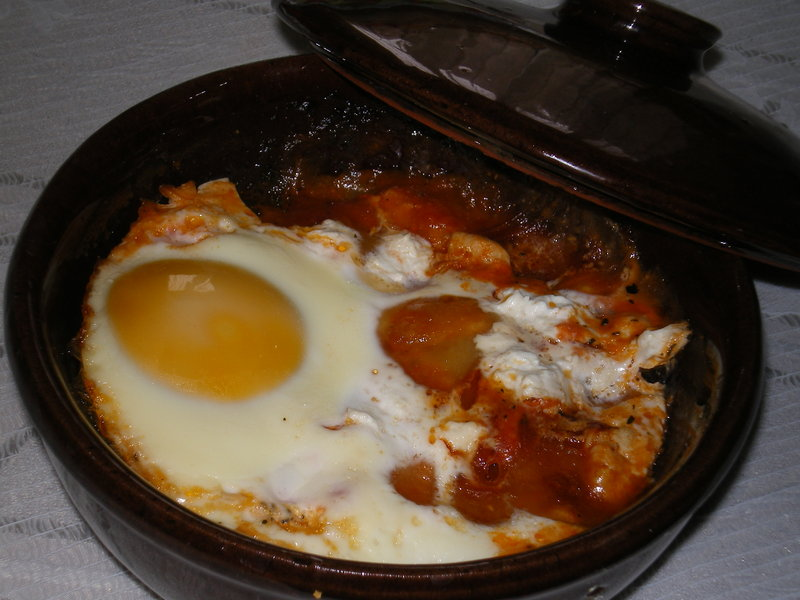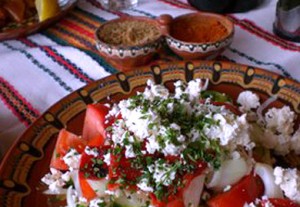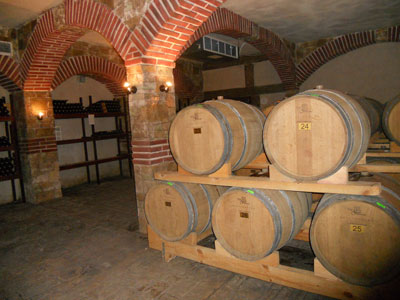Delicious Food and wine
»
»
Delicious Food and wine
The centuries-old Bulgarian culinary traditions have created remarkable combinations of fresh ingredients, a joy for the eye and the palate, a real veritable gastronomic treasure.The Bulgarian culinary geography abounds in delicious specialities and exotic dishes: Shopska salad (fresh tomatoes, cucumbers, onion anf white feta cheese), Bansko-style kapama (meat and vegetables stewed in an earthenware dish), Rodope cheverme (lamb roasted on a spit over an open fire), Danube fish soup and Sozopol-style mussels, Thracian katmi (special kind of pancake) and Dobroudja banitsa.
What can be better than a tasty dish in combination with a cup of good wine!? If you think so, you will be satisfied in Bulgaria.
Because Bulgarian white and red wines are world famous with their excellent quality and have been awarded prizes at international competitions and exhibitions.
What can be better than a tasty dish in combination with a cup of good wine!? If you think so, you will be satisfied in Bulgaria.
Because Bulgarian white and red wines are world famous with their excellent quality and have been awarded prizes at international competitions and exhibitions.
Culinary traditions
When we speak about the Bulgarian culinary traditions we can`t miss to mension the features of the local product Bulgarian yogurt. It is unique because of the bakteria Lactobacillus bulgaricus and Streptococcus thermophilus which can exist only in Bulgaria. These bakteria ingest natural milk sugars and release lactic acid as a waste product. This way they form the specific taste of the Bulgarian yogurt.
Yogurt is the main ingredient of the traditional Balkan drink airan (ayran). Bulgarians prepare it of yougurt mixed with water in ratio 1 pint plain yogurt + 1 pint cold water. In Turkey for example they prepare it in ratio 1 pitn plain yogurt + 2 pints cold water + salt.
Yougurt is also in the base of the traditional cold soup with cucumbers, garlic, dill and nuts called tarator- one of the masters of the local regale. It can be served as a starter, as a side-dish together with the main dish- it is something like salad, drink or fixings.
Bulgarian white feta cheese and yellow cheese are aslo milk products with an international reputation of delisious speciality.
Although it may seems that the local yellow cheese is very similar to the yellow cheese produced in Middle Europe, they are quite different. The most obvious difference is in the way they look: the Middle European cheese has a lot of holes in it and the local yellow cheese doesn`t. The big size and number of the holes in the Middle European cheese are criteria for good quality, while their presence in the Bulgarian yellow cheese speaks about bed quality.
The white feta cheese is obligatory part of the famous traditional Shopska salad ( Shopsky-style salad)- the starter that every Bulgarian dinner and feast begins with. Its simple ingredients sliced tomatoes, cucumbers, onion and fited with shredded white cheese on the top are so popular that humorously identify with the colours of the Bulgarian national flag: white as the cheese and the onion, green as the cucumbers, red as the tomatoes.
Bulgarian white feta cheese can be tasted in different varieties, not only like a part of salad or sauce. Stuffed in peppers, baked in gjuveche (ceramic small dish), in Shopsky style, in Panagjurishte style, like fried pieces, covered with eggs and flour- it offers a lot of tasty options.
Bulgarian traditional pasty banica is known in various types. With cheese, spinach, ryce, scallion or marrow filling in different regions of the country they prepare it in a number of ways but it`s always very delicious.
The famous Bulgarian wines
The archeology, the local folklore and literature give a lot of evidences that the wine traditions in Bulgaria start from neolithic ages and are part of the culture of Thracians, Romans, Greeks, Slavs and Bulgarians. Produced with thousand-year-old traditions Bulgarian wine has the glory of one of the best wines.
More than 100 000 hectares are devoted to growing vines and many parts of the country are blessed with ideal natural conditiones.
Bulgaria is symbolically separated into several wine producing regions. From each of them excellentcan sorts be paised.
For example fine Merlot is produced in southern Bulgaria, in Haskovo winery.
Bulgarian white wines as Riesling, Chardonnay, SauvignonBlanc are also famous all arrond the world.
There are only two traditional varieties that can be called Bulgaria`s card in terms of wine. One is Mavrud, and the other is Melnik, also know as Shiroka Melnishka Loza. Mavrud is grown in central Southern Bulgaria while Melnik belongs to the southwestern part of the county.
The best local white wines come from the northwest regions of the country- from Varna and Pomorie.
From the valley of Roses between the mountains Stara planina and Sredna gora we can enjoy the aromatic Misket wines.
The numberless local wine cellers, the quality wines that they produce are attractive for lots of wine admirers, which choose exactly Bulgaria to spend their holiday here, meeting the beauty of the country and tasting its excellent wines.
When we speak about the Bulgarian culinary traditions we can`t miss to mension the features of the local product Bulgarian yogurt. It is unique because of the bakteria Lactobacillus bulgaricus and Streptococcus thermophilus which can exist only in Bulgaria. These bakteria ingest natural milk sugars and release lactic acid as a waste product. This way they form the specific taste of the Bulgarian yogurt.
Yogurt is the main ingredient of the traditional Balkan drink airan (ayran). Bulgarians prepare it of yougurt mixed with water in ratio 1 pint plain yogurt + 1 pint cold water. In Turkey for example they prepare it in ratio 1 pitn plain yogurt + 2 pints cold water + salt.
Yougurt is also in the base of the traditional cold soup with cucumbers, garlic, dill and nuts called tarator- one of the masters of the local regale. It can be served as a starter, as a side-dish together with the main dish- it is something like salad, drink or fixings.
Bulgarian white feta cheese and yellow cheese are aslo milk products with an international reputation of delisious speciality.
Although it may seems that the local yellow cheese is very similar to the yellow cheese produced in Middle Europe, they are quite different. The most obvious difference is in the way they look: the Middle European cheese has a lot of holes in it and the local yellow cheese doesn`t. The big size and number of the holes in the Middle European cheese are criteria for good quality, while their presence in the Bulgarian yellow cheese speaks about bed quality.
The white feta cheese is obligatory part of the famous traditional Shopska salad ( Shopsky-style salad)- the starter that every Bulgarian dinner and feast begins with. Its simple ingredients sliced tomatoes, cucumbers, onion and fited with shredded white cheese on the top are so popular that humorously identify with the colours of the Bulgarian national flag: white as the cheese and the onion, green as the cucumbers, red as the tomatoes.
Bulgarian white feta cheese can be tasted in different varieties, not only like a part of salad or sauce. Stuffed in peppers, baked in gjuveche (ceramic small dish), in Shopsky style, in Panagjurishte style, like fried pieces, covered with eggs and flour- it offers a lot of tasty options.
Bulgarian traditional pasty banica is known in various types. With cheese, spinach, ryce, scallion or marrow filling in different regions of the country they prepare it in a number of ways but it`s always very delicious.
The famous Bulgarian wines
The archeology, the local folklore and literature give a lot of evidences that the wine traditions in Bulgaria start from neolithic ages and are part of the culture of Thracians, Romans, Greeks, Slavs and Bulgarians. Produced with thousand-year-old traditions Bulgarian wine has the glory of one of the best wines.
More than 100 000 hectares are devoted to growing vines and many parts of the country are blessed with ideal natural conditiones.
Bulgaria is symbolically separated into several wine producing regions. From each of them excellentcan sorts be paised.
For example fine Merlot is produced in southern Bulgaria, in Haskovo winery.
Bulgarian white wines as Riesling, Chardonnay, SauvignonBlanc are also famous all arrond the world.
There are only two traditional varieties that can be called Bulgaria`s card in terms of wine. One is Mavrud, and the other is Melnik, also know as Shiroka Melnishka Loza. Mavrud is grown in central Southern Bulgaria while Melnik belongs to the southwestern part of the county.
The best local white wines come from the northwest regions of the country- from Varna and Pomorie.
From the valley of Roses between the mountains Stara planina and Sredna gora we can enjoy the aromatic Misket wines.
The numberless local wine cellers, the quality wines that they produce are attractive for lots of wine admirers, which choose exactly Bulgaria to spend their holiday here, meeting the beauty of the country and tasting its excellent wines.


